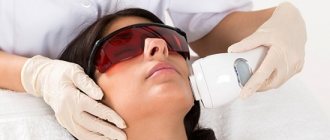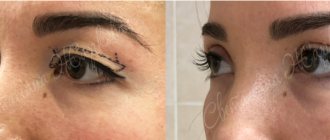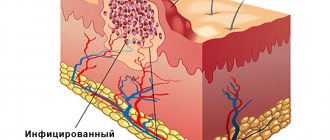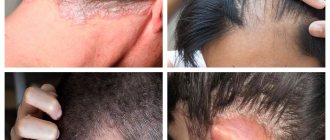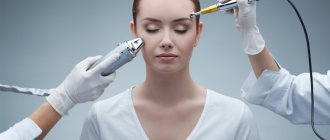Hormonal status and skin
The article presents data on changes in the dermis that occur when the function of the endocrine glands is disrupted, and on methods for their correction.
Introduction
The skin is considered the largest human organ. Along with the integumentary and protective functions, it participates in the exchange of nutrients and biologically active substances and vitamins.
Skin and subcutaneous fat are hormone-producing tissue that expresses enzymes, cytochrome P450scc. The latter carries out the first stage of steroidogenesis: the conversion of cholesterol to pregnolone. Cytochrome P450scc and its steroid precursors are converted into corticosteroids or sex hormones [1]. In these structures, local synthesis of all elements of the hypothalamic-pituitary-adrenal axis occurs.
At the same time, the skin is a target organ for many hormones, including sex steroids - their receptors are present in all structures of the dermis [2].
The clear and balanced functioning of the structures of the dermis, depending on the state of the body, and primarily on the state of the endocrine system, determines its appearance and health.
Changes in the state of the dermis due to dysfunction of the endocrine glands
The influence of the thyroid gland on the condition of the skin is determined by the level of hormones it produces. As their level increases, the skin becomes tender, sensitive to touch, moist, as sweating is increased, and areas of pigmentation are noted. With a decrease in hormone production - dry, rough, pale with a yellowish tint, which is due to insufficient blood supply. Characteristic changes in the skin appendages (nails and hair) are fragility, dryness, and thinning [3].
MK Ahsan et al. (1998) discovered nuclear receptors for thyroid hormones in sebaceous gland cells. Increased stimulation of them was associated with an increase in skin oiliness and the development of acne [4], while decreased stimulation was associated with dryness.
In terms of cosmetic effect, corticosteroids, derivatives of the adrenal cortex, are no less important. With their increased secretion, women experience excess hair growth on the face, limbs, abdomen, and other parts of the body, and acne. Androgens play an important role in increasing the size of the sebaceous glands; they, like thyroid hormones, stimulate the secretion of sebum into the ducts of the sebaceous glands, as well as the proliferation of keratinocytes [5–8]. That is why during puberty, when the adrenal glands begin to actively synthesize dehydroepiandrosterone sulfate, a precursor of testosterone, oily skin increases significantly in adolescents [9]. As a result, favorable conditions are created for the active growth of microbial pathogens, the development of an inflammatory reaction and the appearance of acne [10].
The most severe skin lesions associated with androgen imbalance and characterized by the development of acne are observed in congenital, usually genetically determined, diseases caused by mutations in genes encoding receptor transporters or hormone receptors [11]:
1) with polycystic ovary syndrome; 2) Itsenko-Cushing syndrome; 3) congenital adrenal hyperplasia (CAH syndrome); 4) combination of hyperandrogenism, insulin resistance and acanthosis nigricans (HAIR-AN syndrome); 5) constitutional hirsutism of adrenal origin (main manifestations are seborrhea, deep purulent acne, hirsutism, alopecia) (SAHA syndrome); 6) acromegaly; 7) one of the variants of the course of psoriatic arthritis (synovitis, deep purulent acne, pustulosis of the palms and soles, keratoderma, osteitis of various localizations) (SAPHO syndrome); congenital dystrophic epidermolysis bullosa, characterized by skin lesions in the form of gangrenous pyoderma, acne and purulent arthritis (PAPA syndrome); 9) acrocephalosyndactyly of the first type, characterized by malformation of the bone skeleton, bone fusions of the face and skull, membranous fusions of the fingers of the extremities (Apert syndrome).
2) Itsenko-Cushing syndrome; 3) congenital adrenal hyperplasia (CAH syndrome); 4) combination of hyperandrogenism, insulin resistance and acanthosis nigricans (HAIR-AN syndrome); 5) constitutional hirsutism of adrenal origin (main manifestations are seborrhea, deep purulent acne, hirsutism, alopecia) (SAHA syndrome); 6) acromegaly; 7) one of the variants of the course of psoriatic arthritis (synovitis, deep purulent acne, pustulosis of the palms and soles, keratoderma, osteitis of various localizations) (SAPHO syndrome); congenital dystrophic epidermolysis bullosa, characterized by skin lesions in the form of gangrenous pyoderma, acne and purulent arthritis (PAPA syndrome); 9) acrocephalosyndactyly of the first type, characterized by malformation of the bone skeleton, bone fusions of the face and skull, membranous fusions of the fingers of the extremities (Apert syndrome).
10–30% of women in the population experience symptoms of hyperandrogenism (acne, seborrhea and hirsutism) [12]. Most often, patients consult an obstetrician-gynecologist and dermatologist with complaints of acne vulgaris.
), which arise as a result of imbalances in sex hormones and functional disorders of other organs of the endocrine system.
Dehydroepiandrosterone, a precursor of androstenediol and androstenedione, also has an anti-inflammatory, vasodilating effect, and in postmenopausal women it helps improve the trophic properties of the mucous membranes, including the vagina [13, 14].
A decrease in the synthesis of growth hormones in young people leads to an increase in the production of subcutaneous fat, a decrease in muscle mass and tone of both the whole body and the skin. The skin becomes dry and thin [15].
Female sex hormones have a significant influence on the processes occurring in the skin and its composition [2]. Estrogen receptors beta, progesterone and androgens are expressed in keratinocytes, fibroblasts and macrophages of the skin, estrogen receptors alpha - in skin fibroblasts and macrophages [16–20]. Their concentration in different areas of the skin is different; the largest number of the former were found on the skin of the face [21].
The presence of estrogen receptors beta and alpha in melanocytes causes hyperpigmentation when estrogen levels increase, for example, when taking estrogen-containing drugs [22, 23].
During pregnancy, there is a sharp change in the ratio of estrogen and progesterone. Thus, in the first trimester of pregnancy, the level of estradiol increases five times, at 39 weeks – by 32 times, while the level of androgens remains stable [24]. The main source of estrogen during pregnancy is the placenta, where the hormones are aromatized.
During pregnancy, the level of circulating dehydroepiandrosterone, which temporarily performs a hormone replacement function, decreases, which has a beneficial effect on the skin [25, 26].
Estrogens and androgens perform antagonistic functions. Estrogens increase the antioxidant properties of the skin, activate telomerase, have an anti-inflammatory effect, stimulate angiogenesis [27], and androgens, on the contrary, have a pro-inflammatory effect [26, 28]. Through various mechanisms, estrogens are involved in the regulation of proliferation, morphogenesis, differentiation and apoptosis of skin cells. Moreover, their influence is carried out, as a rule, through interaction with specific intranuclear estrogen receptors with subsequent regulation of gene transcription.
The role of estrogen in the development of acne is not well understood. Sex steroids (estrogens and progesterone) have a dose-dependent effect on cellular immunity. An increase in the level of estrogen and progesterone during the periovulatory period helps to suppress a delayed-type hypersensitivity reaction; their relatively low level before, during and after menstruation leads to a decrease in reactivity, the development of atopic dermatitis, and the appearance of skin rashes in the luteal phase of the menstrual cycle. In the literature, the presented mechanism is described as a manifestation of autoimmune progesterone- and estrogen-mediated dermatitis [29], observed in the second phase of the cycle.
Salt and water retention due to increased estrogen levels leads to swelling of the subcutaneous tissue, which is considered one of the manifestations of hormonal imbalance, in particular with premenstrual syndrome [30].
Estrogens affect the functioning of epidermal and dermal structures, including blood vessels, hair follicles, sebaceous/apocrine glands, eccrine glands and melanocytes. They significantly affect the thickness, elasticity of the skin, its hygroscopic properties, vascularization, barrier function, hair growth, etc. [30], and prevent cell aging [31].
Reducing the amount of steroids in women in adulthood leads to skin aging [32]. In conditions of estrogen deficiency, dryness, decreased firmness and elasticity, and skin thickness are noted. This is the result of changes in the quantitative and qualitative characteristics of collagen and elastic fibers. These changes occur most intensively in the first five years of menopause [2, 33].
The effect of progesterone on the skin and sebaceous glands remains the subject of debate and scientific research. It was previously believed that sebum production in women during the menstrual cycle was controlled by progesterone. Although the hormone is a competitive inhibitor of 5-alpha reductase, its suppressive effect on sebaceous gland activity and sebum production is assessed as minimal [34]. The effects of progesterone correlate with its level (acne, eczema, and atopic dermatitis worsen against the background of peak values) and intensify during the premenstrual period. As a result of cyclical fluctuations in sex steroids, the immune and barrier functions of the skin are reduced. As a result, its condition changes [29].
Thus, the skin is a neuroendocrine organ with hormonal and hormone-producing functions [35]. Violation of synthesis, changes in the activity of local or central steroids can lead to the development of inflammatory, autoimmune and other diseases.
Restoring skin condition
Cosmetic problems often cause irritability, depression, social discomfort, disruption of interpersonal relationships, distress and therefore require solutions [12]. Treatment should be carried out taking into account the degree of skin damage and the nature of the pathological process.
If changes in the skin are caused by diseases of the thyroid gland, a set of measures is indicated: rational nutrition, the use of medical and surgical correction methods. It is also necessary to observe a work and rest regime, since changes in thyroid function are often observed after infectious diseases, severe psychological trauma, and physical overload. Vitamins A, B1, B6, B12, C and E should be taken in sufficient quantities to compensate for their deficiency and prevent it.
Drug correction is aimed at suppressing thyroid function in the case of hyperthyroidism or replenishing the lack of hormones in hypothyroidism.
Etiopathogenetic therapy of hyperandrogenism involves the use of drugs that have an antiandrogenic effect. This fully applies to combined oral contraceptives, more than 50 years of experience in the use of which indicates not only their high effectiveness in preventing unwanted pregnancy, but also a positive effect on the woman’s body.
It has been established that microdoses of drospirenone-containing combined oral contraceptive drugs have progestational, antiandrogenic and antimineralocorticoid effects [36, 37].
Drospirenone (6b, 7b, 15b, 16b-dimethylene-3-hydroxy-17a-pregn-4-ene-21,17carbolactone) is a derivative of 17a-spirolactone [38, 39] and its pharmacological properties are as close as possible to endogenous progesterone. It has high affinity for aldosterone receptors and low affinity for androgen receptors and does not bind to either glucocorticoid or estrogen receptors. A fundamentally important clinical characteristic of drospirenone is the ability to neutralize a number of side effects of ethinyl estradiol in the absence of negative androgen-dependent side reactions [40].
The results of numerous studies have proven the high contraceptive effectiveness of drospirenone-containing drugs - the Pearl index is 0.7; clinical trials have demonstrated their non-contraceptive properties: reducing fluid retention, improving skin condition and general well-being [41, 42].
New combined monophasic contraceptives Vidor and Vidor micro have been registered in Russia. Each contraceptive tablet contains drospirenone/ethinyl estradiol 3 mg/30 mcg and 3 mg/20 mcg, respectively.
The antiandrogenic activity of drospirenone-containing drugs is due to their direct blocking effect on androgen receptors, as well as an indirect antiandrogenic effect: a decrease in the synthesis of androgens in the ovaries and an increase in the blood level of sex steroid binding globulin.
The clinical effectiveness of drospirenone-containing combined oral contraceptives in hyperandrogenic conditions is similar to the clinical effectiveness of combined contraceptives that include the progestin component cyproterone acetate. This was proven by the results of comparative studies involving patients suffering from acne and seborrhea, as well as with a confirmed diagnosis of polycystic ovary syndrome [43].
Drospirenone also has a positive effect on carbohydrate and lipid metabolism. The drug does not impair carbohydrate tolerance and does not increase fasting insulin levels [44].
Today, along with drospirenone, there is another promising progestogen for oral contraception - dienogest. The drug is characterized by high safety, as well as a therapeutic effect in hyperandrogenism [45, 46]. In addition, a combined oral contraceptive containing dienogest (Diecyclen) controls the menstrual cycle well, has high specificity for gestagen receptors, and has a pronounced selective antiproliferative effect on the endometrium. Diecyclen has a moderate antigonadotropic effect and has a positive effect on the function of the central nervous system.
Contraceptive drugs Vidora, Vidora micro and Diecyclen go through the full production cycle in Europe, from the substance to the secondary packaging, which guarantees their quality.
The Vidora and Vidora micro preparations contain, in addition to 21 active tablets, seven placebo tablets, which is important for developing adherence to therapy due to the need for continuous use of the contraceptive.
The variety of positive effects of hormonal drugs is largely due to their gestagenic component [47]. In particular, modern contraceptives Vidora, Vidora micro and Diecyclen, which contain the progestogens drospirenone and dienogest, have an antiandrogenic effect. They block the binding of androgens to specific receptors located in the sebaceous hair follicles, and thus help reduce sebum production, slow down hair growth, reduce acne and restore skin condition.
In the adrenal form of hyperandrogenism, taking contraceptive pills helps to improve the condition of the skin, therefore, before prescribing estrogen-gestagen drugs, examination and clarification of the source of the increased level of androgens is required.
Achieving a stable clinical effect when taking combined oral contraceptives with an antiandrogenic component is possible in both ovarian and mixed forms of hyperandrogenism [48].
During the postmenopausal period, women experience hypoestrogenism and, as a consequence, degenerative changes in the elastic fibers of the dermis. This leads to decreased tone, deepening of skin folds and the appearance of wrinkles. Therapy with estrogen preparations helps to increase the content of collagen fibers and skin thickness [2, 49]. Estrogens, which have antioxidant properties, prevent skin aging. In addition, they have additional positive effects on bone tissue, the cardiovascular system and other organs [30].
Conclusion
A hierarchical system has been built in the skin, which involves immune, biochemical, hormonal interactions to protect the body from the influence of environmental factors and biological factors, as well as to maintain local homeostasis.
Skin cells contain machinery for the production of glucocorticoids, androgens and estrogens or their precursors, or alternatively through the conversion of cholesterol into pregnenolone and biologically active steroids. Examples of such products are corticosterone, cortisol, testosterone, dihydrotestosterone and estradiol. Their local synthesis is regulated by adrenocorticotropic, gonadotropin-releasing hormones and cytokines [35]. The regulatory effects of hormones and sex steroids, used as therapeutic or preventive measures for various pathological processes, have a positive effect on the body as a whole and on the condition of the skin in particular.
Melatonin
Feeling good and looking fresh is hardly possible without normal sleep, and melatonin is responsible for its quality. Its synthesis occurs at night, from approximately midnight to four in the morning, during sleep and only in complete darkness. Night owls who are not sleeping at this time need to monitor their melatonin levels especially carefully.
Melatonin neutralizes the destructive effects of oxidative processes - it binds free radicals that are formed during the oxidation of, for example, fats. Oxidative stress is one of the main causes of visual aging of the skin (loss of shine and elasticity), so the condition of the skin directly depends on the level of melatonin. The level of melatonin is closely related to the level of another important hormone - cortisol, and it is the smooth change in their concentrations that brings us from sleep to wakefulness when daylight hours come. If you sleep in the light, there is more cortisol in the body and less melatonin.
DHEA
This abbreviation stands for dehydroepiandrosterone. It is also called the “mother of sex hormones” because it produces estrogens and testosterone. And if previously it was believed that this was the end of the role of DHEA, today we know: it is more powerful and capable of slowing down aging! Already at the age of 30, the production of DHEA in the body begins to steadily decline. And this is one of the explanations why the skin ages. The faster the DHEA deficiency grows, the sooner we will notice that it is covered with a treacherous network of wrinkles, the features of the face and neck have lost their former elegance, and the hair has become less thick and thinner.
What to do?
Fortunately, DHEA deficiency can always be supplemented. For example, taking natural preparations with dioscorea (wild yam) extract, which increases the amount of DHEA in the body.
American scientists also discovered that wild yam has a unique ability to stimulate the production of somatotropic hormone, which also prevents us from aging prematurely. It is called not only a “growth hormone”, but also a unique “fountain of youth”. Somatotropic hormone literally transforms the skin, making it more elastic and toned, helping to smooth out wrinkles and improve complexion.
Cream "BotoEffect", 15 g, Qi-Klim
450 ₽
Dietary supplement NOT A MEDICINE
By the way, wild yam is also excellent in cosmetics! Combine taking wild yam preparations internally with the use of natural anti-age cosmetics based on it, and enjoy your reflection in the mirror!
How to find out your balance of female beauty hormones?
Proper maintenance of the balance of sex hormones allows you to maintain female beauty and health. Modern medicine has gained such a unique opportunity thanks to laboratory diagnostics.
The levels of all important hormones are determined using venous blood tests. A comprehensive analysis of sex hormones helps solve many problems in the field of dermatology and trichology (medical disciplines dealing with diseases of the skin and hair), gynecology, reproductive medicine and sexology, which were previously considered insoluble.
Using laboratory tests you can evaluate:
- hormone concentration in the blood;
- there is a connection between problems with appearance or health and hormonal levels;
- changes in the content of one or another hormone over time, fluctuations over a certain period of time (days, weeks, months);
- the effectiveness of the treatment.
What hormones need to be checked?
As we found out, a whole complex of biologically active substances is responsible for attractiveness and femininity. To assess the state of a woman’s hormonal levels, it is necessary to measure the following indicators in the blood:
- estradiol (E2) is the main hormone from the estrogen group;
- testosterone (total);
- LH (luteinizing hormone);
- FSH (follicle stimulating hormone);
- progesterone;
- prolactin;
- SHBG is a protein responsible for the transport of sex hormones to receptors distributed throughout the body;
- DHEA-S (dehydroepiandrosterone sulfate).
Progesterone
The main task of progesterone is the development of the egg and its placement in the uterus, which is why it is often called the pregnancy hormone. In non-pregnant women, progesterone is also present and increases in the second phase of the menstrual cycle, which, unfortunately, negatively affects appearance. “Progesterone promotes fluid retention in the body, increases the permeability of the vascular wall, the skin becomes stretchable, the secretion of sebum increases and acne appears. Puffiness of the face may appear due to fluid retention,” says Irina Vyatkina. Progesterone also actively promotes fat storage, preparing us for pregnancy, even if we don't plan for it. Therefore, in the second phase of the cycle, many people gain one or two extra pounds. In addition, progesterone reduces the body's resistance to infections, which has a beneficial effect on the pathogenic microflora of the skin due to weakened immunity and often leads to the formation of acne.
Insulin
Without a doubt, this is the main hormone that regulates sugar levels. It prevents us from aging prematurely, but only under one condition - if its level in the blood is within normal limits. The danger for us is not only a deficiency of insulin, but also an excessive increase in its level. Let's say more: no hormone accelerates aging as much as excess insulin! If its level constantly goes off scale, this will lead to serious health problems: for example, hypertension, cardiovascular diseases, obesity, high cholesterol, diabetes (yes, it can occur not only with a deficiency of insulin, but also with its excess ).
Olijim Vitamins for diabetes, 60 capsules, Evalar
360 ₽
Dietary supplement NOT A MEDICINE
What to do?
Pay special attention to the guest from the tropics - the gymnasium! It turns out that the extract obtained from this evergreen woody vine increases the production of insulin and increases the sensitivity of cells to it, which in turn helps maintain normal glucose levels.
Cortisol
Melatonin affects the production of cortisol, a stress hormone that is synthesized by the adrenal glands and helps to survive in emergency situations. “When cortisol production changes, carbohydrate metabolism and insulin production change, which leads to changes in the appearance and quality of the skin. With a high level of insulin, the functioning of the sebaceous and sweat glands is disrupted, the skin loses its natural protective properties, is easily affected by bacterial and fungal infections, loses its firmness and elasticity, and collagen synthesis decreases. As cortisol levels rise, the skin becomes thinner and becomes prone to pigmentation. With normal cortisol production, the skin is elastic, smooth and beautiful,” says Irina Vyatkina. Elevated cortisol contributes to the accumulation of fat in the face and abdomen, which is why it is true that stress interferes with weight loss.
When should you check your hormone levels?
The following situations may be the reason for taking a blood test to assess hormonal levels:
- increased hair loss;
- acne on the face, décolleté or back, which is difficult to treat or reappears periodically;
- excess pigmentation on the skin;
- excess weight, which is difficult to correct with diets.
In addition, hormonal levels should be monitored if you notice the following manifestations:
- menstrual irregularities, too heavy or long menstrual bleeding or, conversely, very scanty;
- too vivid manifestations of premenstrual or menopausal syndrome (irritability, anxiety, insomnia, hot flashes, etc.);
- decreased libido.
As mentioned above, assessing the hormonal balance is very important during age-related changes in a woman’s body. An analysis of the level of hormones in the blood is required when:
- menopause;
- postmenopausal period.
Beauty of the figure
The pleasant roundness of the figure that men like so much is formed under the influence of the hormone estrogen. In addition to the production of estrogen hormones by the gonads, they can be synthesized in fat deposits. Therefore, the balance of hormones with significant weight loss or weight gain can change noticeably.
Hormonal weight gain, which often occurs in women, occurs under the influence of excess progesterone. Weight loss under the influence of endocrine substances is also possible. This ability has been demonstrated by dehydroepiandrosterone (DHEA), which helps the body cope with fat deposits.




